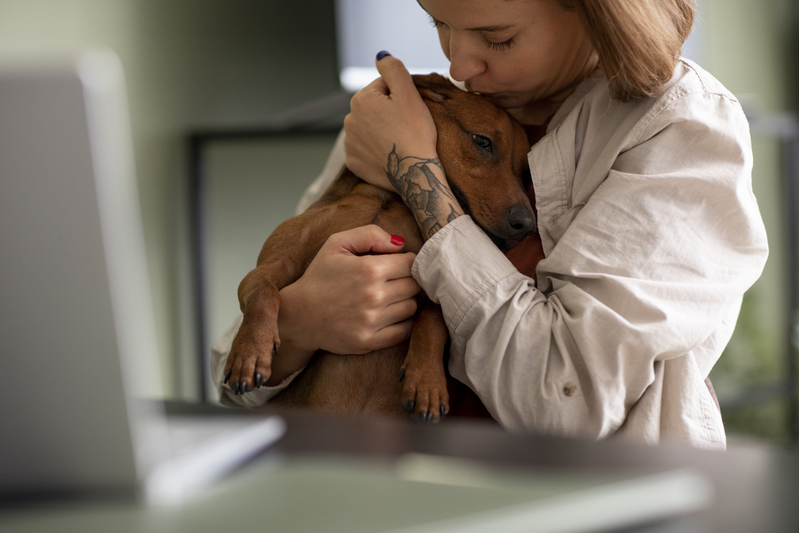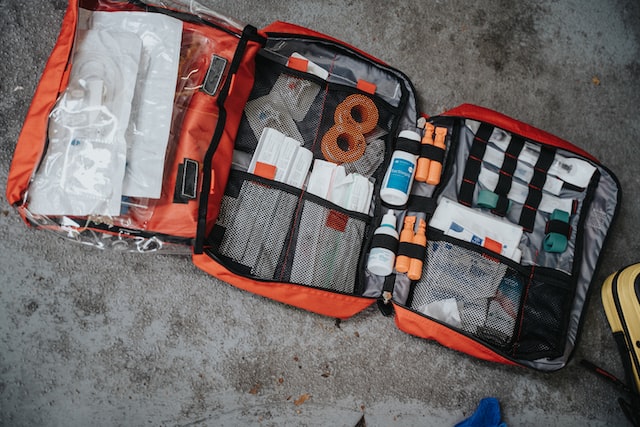- What is deep pressure stimulation?
- Why is deep pressure stimulation important?
- How does deep pressure stimulation work in general?
- Who can benefit from Deep Pressure Therapy?
- Psychiatric Service Dogs and Deep Pressure Therapy
- Main Tasks Of a Psychiatric Service Dog That Provides a DPT
- How to train your dog to perform the task “Lap”
- How to train your dog to perform the task “Chin”

Many of you are already familiar with the different service dog types. A service dog is trained to perform specific tasks for the benefit of an individual with a disability. This disability may be physical, sensory, mental, psychiatric, or intellectual. The new DOT regulations from April 2021 provide some clarification and limitations of the term “service animal”. Emotional Support Animals and any comfort-providing animals are no longer considered service animals, as they are not trained to provide specific tasks.
On the other hand, psychiatric service dogs are considered service dogs that provide assistance to people with psychiatric disabilities like anxiety disorders, depression, post-traumatic stress disorder (PTSD).
One of the most effective and beneficial tasks that a Psychiatric Service Dog may be trained to perform is deep pressure stimulation or deep pressure therapy. We want to let you know more about deep pressure stimulation because it is a vital part of the work performed by psychiatric service dogs.
What is deep pressure stimulation?
Deep Pressure Stimulation (DPS), is a tactile stimulation provided as gentle pressure to the body via tugging, stroking, cuddling or wrapping, that relaxes the nervous system. It can be applied through different devices: massage tools, hands, swaddles, or Psychiatric Service Dogs, specially trained to provide deep pressure therapy. If the therapy has been provided properly, it has an organizing and calming effect on the nervous system and makes the recipient feel calm and peaceful.
Why is deep pressure stimulation important?
Deep pressure stimulation is an essential tool for those suffering from mental and emotional difficulties, as it provides relief from stress, fear and anxiety. By applying mild but consistent pressure on the torso, the brain responds by releasing hormones that create a feeling of calmness and peace. This can be incredibly helpful in times of distress, providing relief from symptoms of depression, panic attacks and PTSD. Additionally, deep pressure stimulation can also help reduce aggression, hyperactivity and impulsiveness in children with autism spectrum disorders.
Deep pressure stimulation can be used in both short-term and long-term situations to provide comfort and relief for those in need. This type of therapy can be achieved with a variety of tools, from weighted blankets to specialized pressure vests. Service Dog Training School offers training programs for handlers and owners to help them effectively use deep pressure stimulation techniques in order to provide the most benefit for their dog or patient. We also offer educational resources so that everyone involved can understand the best methods for applying these techniques for maximum positive outcome. With the goal of providing the highest level of care and comfort to those in need, Service Dog Training School is committed to helping you get the most out of your pressure stimulations. Contact us today to learn more about how we can help you provide the best possible therapy for your dog or patient!
How does deep pressure stimulation work in general?
By providing deep pressure to the body, it begins to run its parasympathetic nervous system (PSNS), replacing the sympathetic nervous system (SNS). This change is known as a switch from “fight or flight” to “rest and digest”.
The sympathetic nervous system is responsible for the body's reactions in stressful situations like when you are late for work, and you barely move in a traffic jam. If you have been in stressful situations for too long, and the sympathetic nervous system indicates many stress-causing factors to the body, this could lead to feelings of anxiety, tiredness, panic attacks, sleep disorders...etc.
When the body starts running the PSNS, the muscles relax and the circulation enhances. Endorphin, dopamine, and serotonin are being produced and create the feeling of happiness. They improve memory, sleep, motivation, and social skills.
People with conditions like autism, sensory processing disorder (SPD), depression, and Alzheimer, are likely to suffer from sensory overload. These individuals are not likely to be able to easily switch from running the (SNS) to running the (PSNS) and even less important factors could trigger the (SNS) and interfere with the feeling of calmness.
Deep touch pressure (DTP) leads to a calming effect when applied to the whole body.
Who can benefit from Deep Pressure Therapy?
It can be used by people with disorders like:
Autism, Depression, Insomnia, Post-Traumatic Stress Disorder (PTSD), Sensory Processing Disorder (SPD), Attention Deficit Disorder (ADD), Tourette’s Syndrome, Restless Leg Syndrome.
Many people with physical as well as sensory and mental disabilities decide to have a service dog in order to enhance their lives. Psychiatric Service Dogs are service dogs trained to provide assistance to a person who deals with mental health disorders like depression, post-traumatic stress disorder (PTSD), schizophrenia, anxiety, or bipolar disorder. One of the most beneficial tasks that a PSD can provide is exactly a deep pressure stimulation or a deep pressure therapy.
Psychiatric Service Dogs and Deep Pressure Therapy
The goals of this therapy may be different, however, in most cases, it is used for grounding and calming persons with a dissociative episode or who got a panic/ anxiety attack. The process may take place differently depending on the dog’s breed, respectively its size, and the amount of pressure that the individual wants to be applied to their body.
If a dog’s breed is large, the dog could provide tactile stimulation through their chin to different parts of their handler’s body.
If the dog’s breed is considered small, the dog partner can sit or lay in the lap of their handler.
Main Tasks Of a Psychiatric Service Dog That Provides a DPT
There are two main tasks or behavior types that a Psychiatric Service Dog is trained to perform when providing a DPT:
Lap and Chin
How to train your dog to perform the task “Lap”
You can try sitting on a couch/chair accompanied by your dog positioned next to you. Tap with your leg eagerly and use sounds with a higher frequency, so that they are more passionate and can stimulate your dog partner to jump into your lap or leg. If your furry friend understands and fulfills the command, you can reward him/her.
If your fluffy friend does not want to jump, you can try providing a treat near to his/her nose as a motivation.
In case your dog partner just does not want to fulfill the task, you can put him/her on furniture around you and motivate him/her to jump up onto your lap. If your dog partner understands what you expect him/her to do, put him/her on the ground and try again with the exercise from this position.
After your fluffy friend starts jumping up on a regular basis and manages to completely understand the task, you can try encouraging him/her to take a laying position.
You need to choose a word and say it in order to stimulate him/her to take this position (the word could be “Lap”, but this is not mandatory).
If you tried making your dog fulfill the task using a treat you can start trying to encourage him/her to achieve this behavior without using such. In some cases, you may need to provide the task, wait for a few seconds, and then give a reward when he/she fulfills the task. You may not want to give too many treats to your dog partner. At this point, you can start providing a treat only if he/she fulfills the task accurately and fast. You may want to keep the sessions short. Even when your dog partner does not show perfect results, respectively does not become a treat 5-6 times, you can still reward him/her. Your dog partner should stay motivated and not get stressed when he/she does not make something the best way possible on the first try.
You can extend gradually the time required for your dog to stay on your lap as well as the time before you give him/her a reward. You may want to improve the duration slowly and to provide a treat for different amounts of time. Furthermore, you can reward your dog after 3 seconds, after 4 seconds, then decrease the period to 2 seconds, and after that increase it to 5 or 6 seconds. The most important rule is that the exercises be provided patiently, step by step.
Read more about Service Dog Positive Reinforcement Training
How to train your dog to perform the task “Chin”
You can try encouraging your dog partner to put his/her nose over your foot or arm using a treat. When you feel the tactile stimulation and the task is considered “fulfilled”, you can reward him/her.
You need to choose a word (similarly to the “Lap” task, it is not necessary to choose the word “Chin”). After choosing a word, you need to say it and after that to encourage your dog partner with a treat to put his/her nose over your arm or foot.
You need to gradually stop giving treats to your dog partner so that he/she can manage to fulfill the command without receiving a treat. However, you still need to mark and reward the task, when you feel a tactile stimulation.
The same approach as the one used for the Lap task has been used here for increasing the duration. First, you can give a treat for shorter amounts of time and then start increasing them gradually. You need to remember to give a reward for 3 seconds, 4 seconds, then for 2 seconds, and then for 5-6 seconds, then again for 1-2 seconds.
For more Psychiatric Service Dog Task Training, we would recommend you browse the syllabus of the SDTSI Certified Service Dog Training Course.














